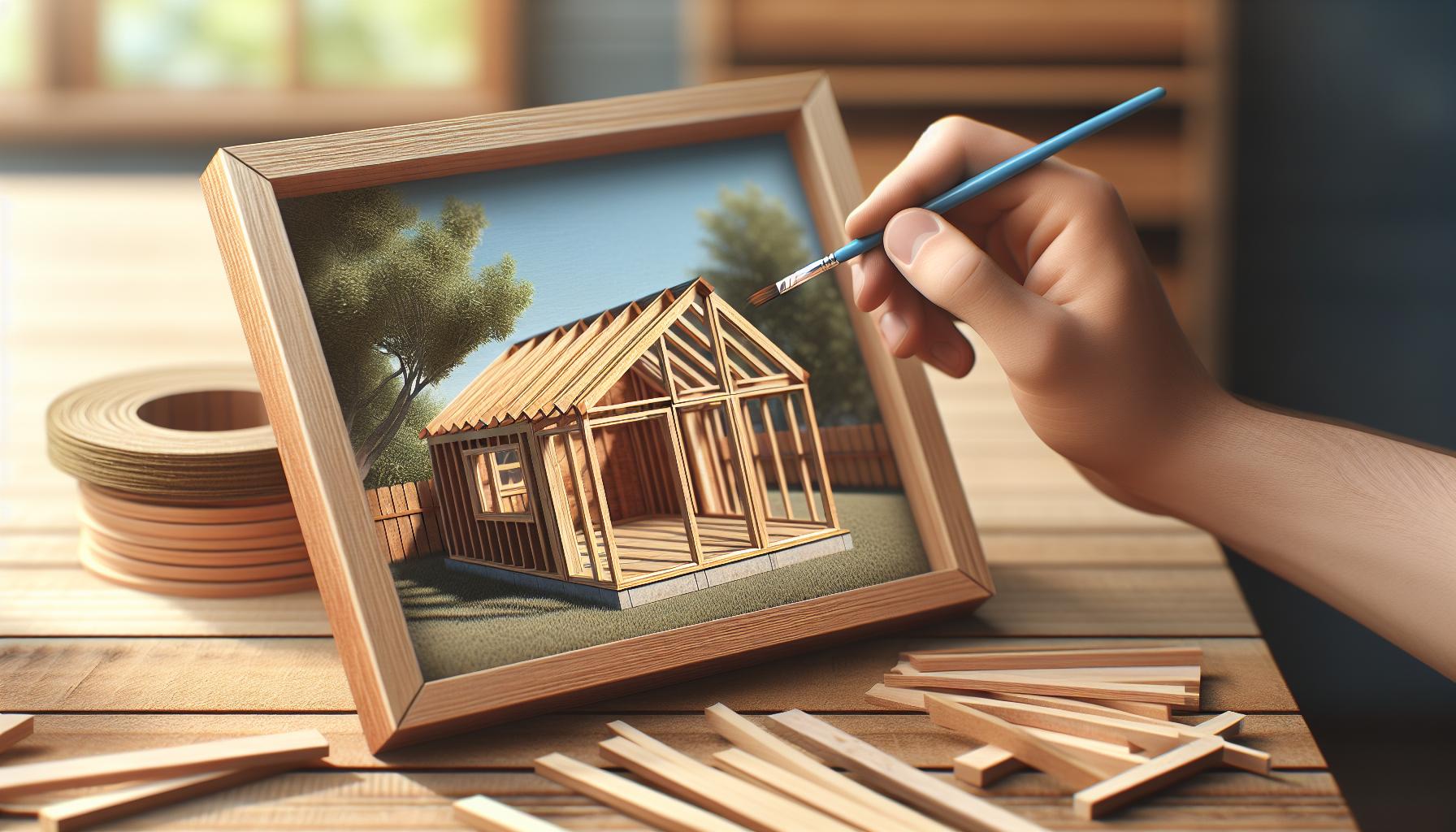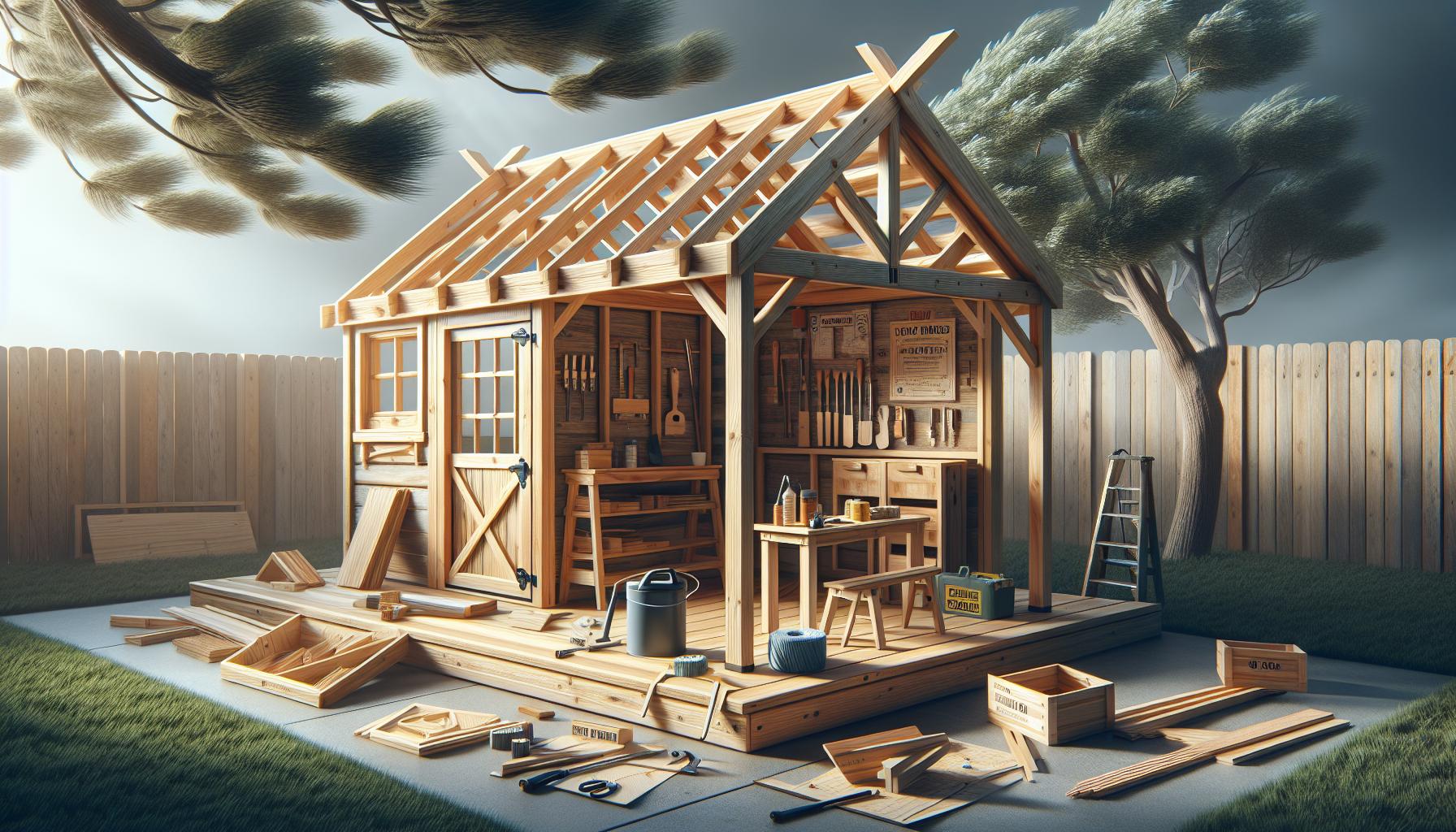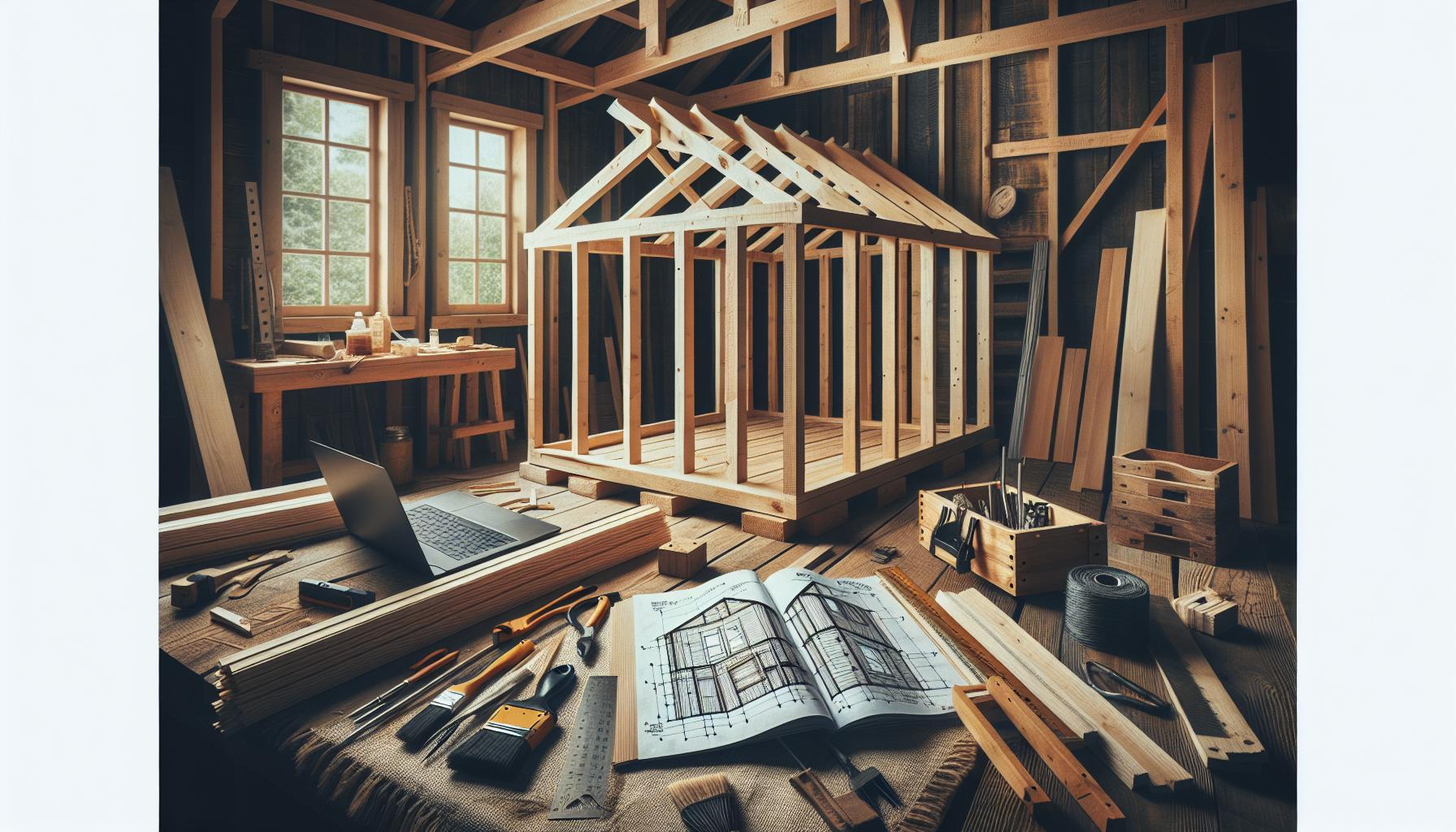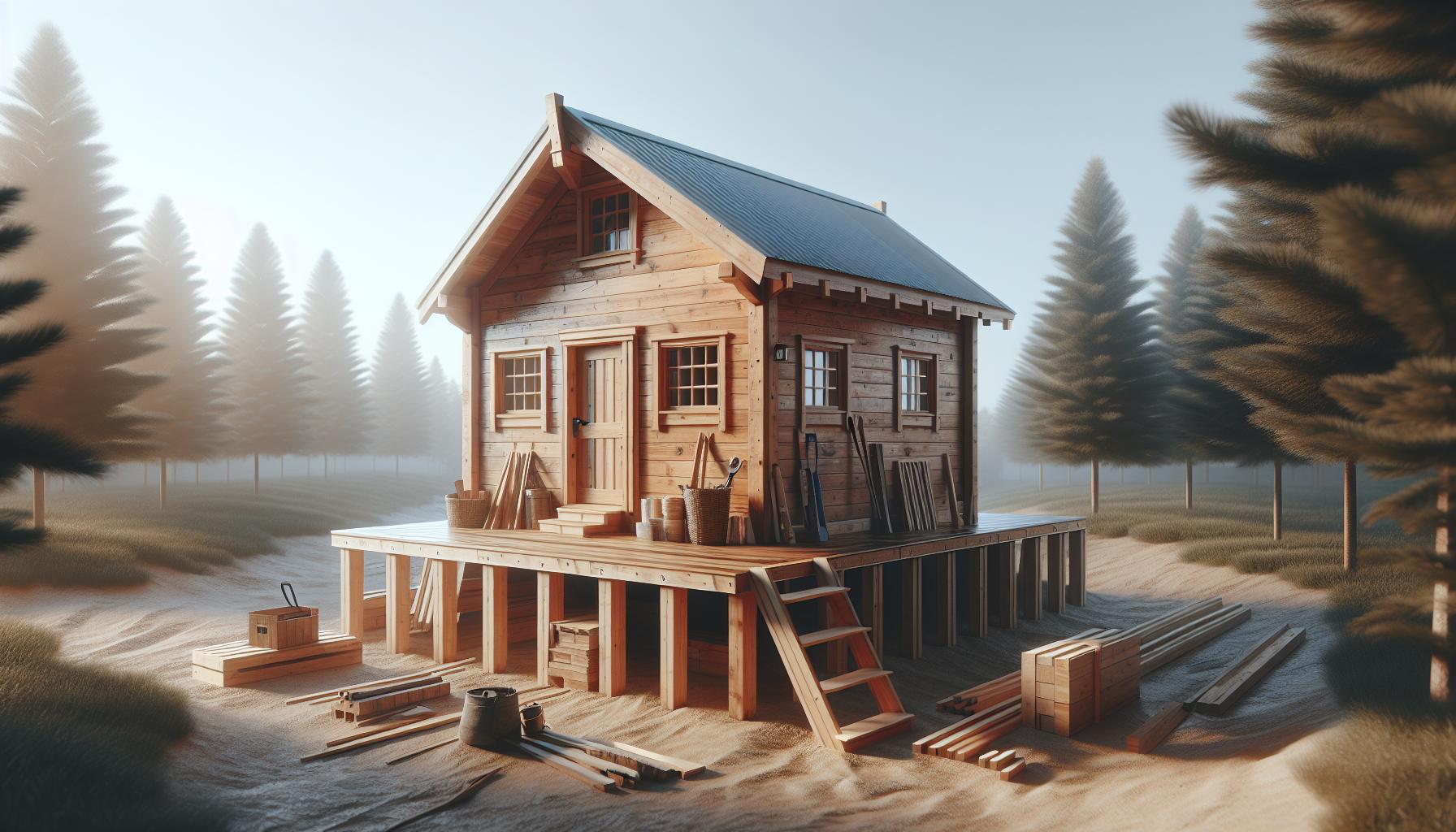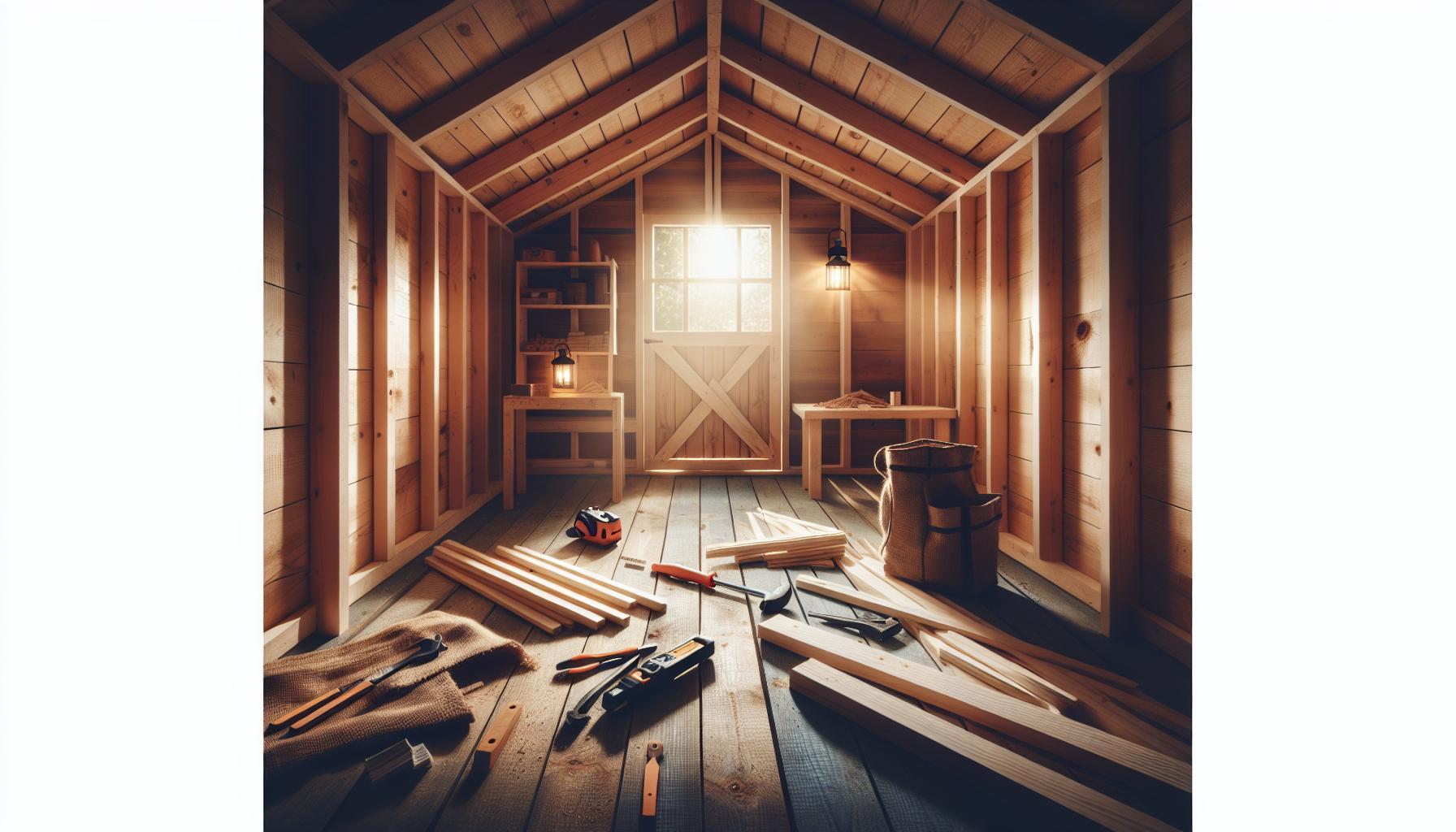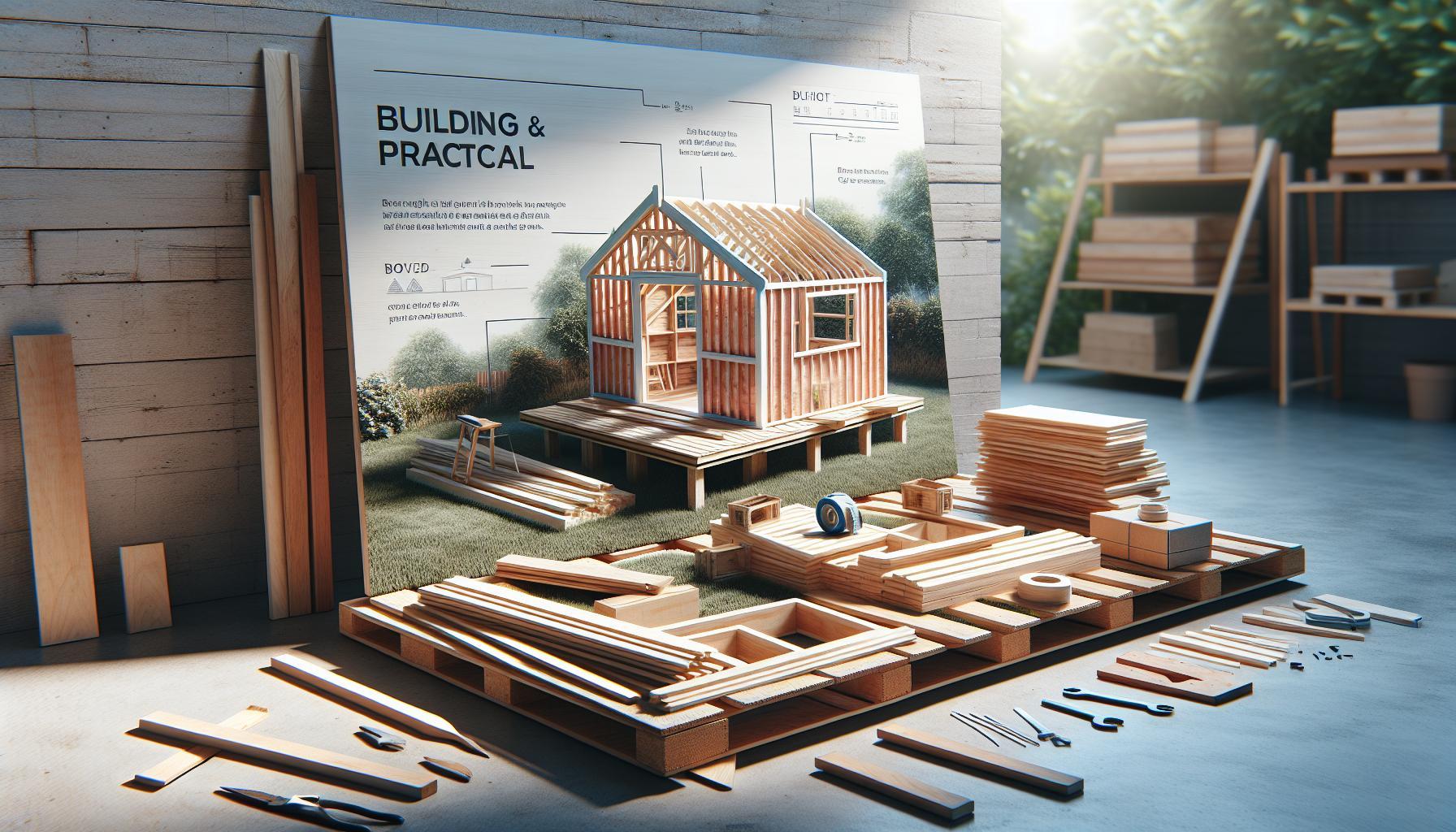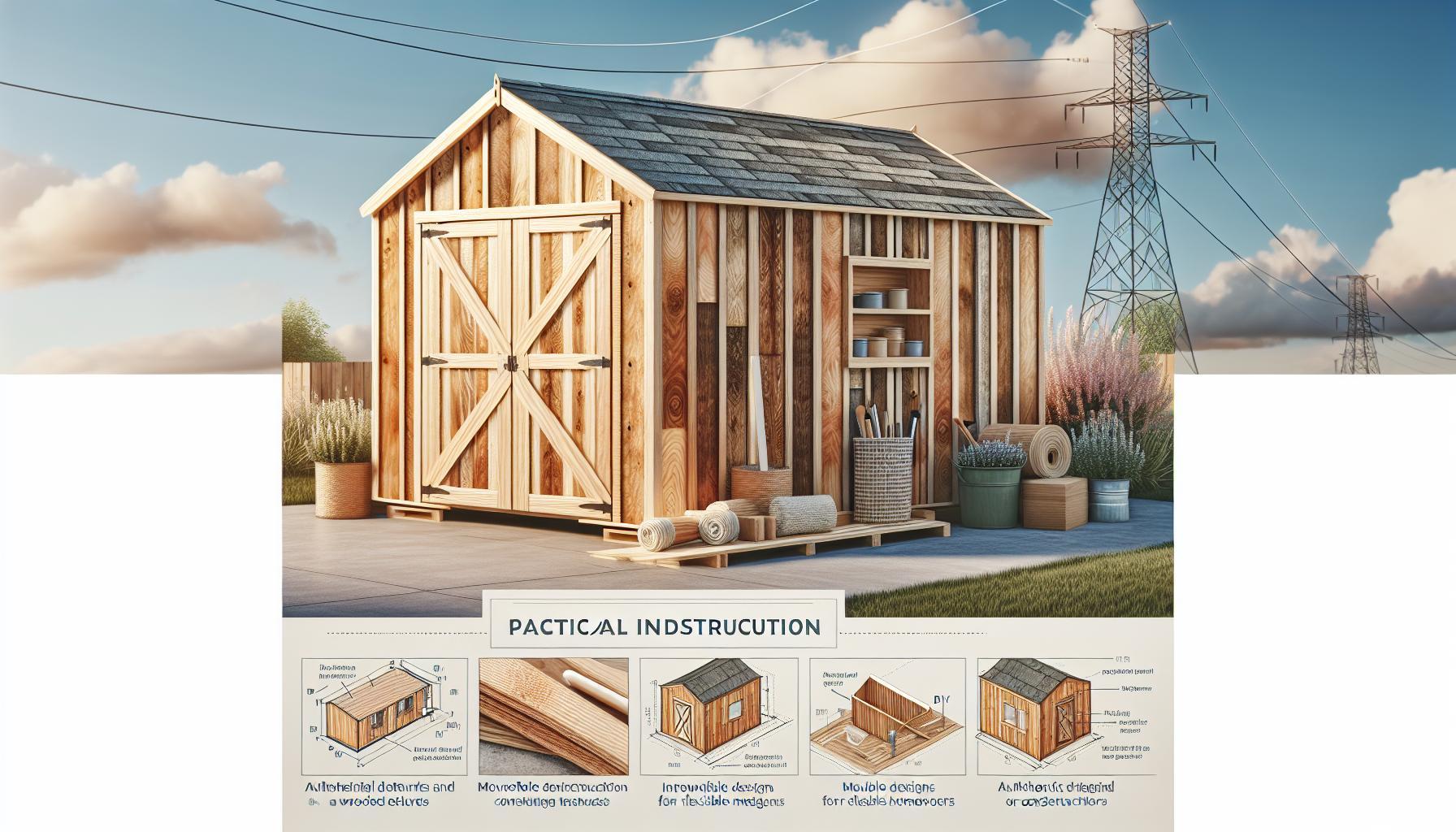With extreme weather events on the rise,the vulnerability of outdoor structures like sheds has become a pressing concern. Building a hurricane-resistant shed not only protects your tools adn equipment but also provides peace of mind amid storm season. Discover innovative reinforcement techniques that ensure your storage solution stands strong against fierce winds and heavy rain.
Understanding Hurricane Forces: What Every shed Builder Should Know
Understanding the forces generated by hurricanes is crucial for anyone looking to build a structure that can withstand these natural disasters. Hurricane winds can reach alarming speeds, causing devastating damage to weak structures. For example, the 2017 hurricane Irma, one of the most powerful hurricanes recorded, brought sustained winds of 185 mph, wreaking havoc in Florida and the Caribbean. Recognizing the forces at play can help shed builders implement robust reinforcement techniques,ensuring that their constructions stand resilient against the fury of nature.
wind Forces and Building Materials
The choice of materials plays a important role in the ability of your shed to endure hurricane winds. Structures are subjected to two primary wind forces: uplift and lateral loading. Uplift occurs when winds pass over a structure, generating a lifting force that can tear a roof off. Lateral loading is the horizontal pressure exerted by winds against the walls. To combat these forces, consider the following materials:
- Pressure-treated wood: This type of wood resists rot and insects, ensuring longevity even in vulnerable areas.
- Metal roofing: Lightweight and resistant to wind uplift, metal roofs are often recommended for hurricane-prone areas.
- Concrete blocks: these offer ample lateral strength and stability, making them an excellent choice for foundations.
Integrating these materials can substantially enhance the structural integrity of your shed. regular inspection and maintenance of these materials can also preemptively address issues that arise over time, promoting a longer lifespan for your structure.
Design Techniques for wind Resistance
In addition to selecting the right materials, applying specific design techniques can bolster your shed against hurricane forces. Here are some actionable strategies to consider:
- Roof Shape: Opt for a sloped roof design that allows wind to flow over instead of causing it to become trapped. A gable roof is frequently enough more resilient than a flat roof.
- Corner Bracing: Install bracing at the corners to provide additional stability and help the structure resist lateral forces.
- Anchoring Systems: Use deep-set anchors to tie your shed securely to its foundation. This prevents it from being uprooted during high winds.
These design considerations can mitigate the risks associated with hurricane forces, ensuring that your shed remains intact when faced with extreme weather conditions.
Table: Estimate of Wind speed Resistance Based on Material
| Material | Wind Speed Resistance (mph) | Notes |
|---|---|---|
| Pressure-Treated Wood | Up to 130 | Can be reinforced with additional screws or bolts. |
| Metal Roofing | Up to 160 | Installation is key; must be fastened securely. |
| Concrete Blocks | Up to 180 | Excellent for long-term durability and resistance. |
Understanding the science of hurricane forces and employing effective reinforcement techniques is essential for anyone considering a hurricane-resistant shed. By carefully selecting materials and integrating resilient designs, you can create a robust structure that stands strong against the elements.
Key Materials for Building a Resilient Shed against High Winds
A well-constructed shed can stand firm against nature’s fury, particularly in regions prone to high winds and storms. To create a resilient structure that can weather these challenges, it’s vital to select the right materials that enhance both its sturdiness and longevity. With the increasing prevalence of severe weather events, many property owners are asking themselves, *Can you build a hurricane-resistant shed? Reinforcement techniques* are pivotal in ensuring their sheds can endure conditions that would otherwise compromise weaker constructions.
Essential Materials for Wind-Resistant Sheds
Utilizing robust materials is the foundation of a shed designed to resist high winds.Here are some key materials to consider:
- Steel or Reinforced Aluminum: These materials are exceptionally strong and can withstand extreme pressures. incorporating steel framing or aluminum siding can greatly enhance the shed’s structural integrity.
- Impact-Resistant Windows: Specialized windows designed to resist shattering under high winds are crucial. Look for solar control low-E glass types that not only protect against winds but also contribute to energy efficiency.
- Marine-Grade Plywood: This type of plywood is treated to resist moisture and withstand environmental wear. It adds strength to the walls and floor of the shed, making it less likely to succumbs to rotting or warping.
- Galvanized Fasteners: Using corrosion-resistant fasteners like screws and bolts is crucial for maintaining structural stability over time,especially in harsh weather conditions.
Consideration of Structural Design
The right materials should be coupled with an effective design to build a truly wind-resistant shed. This includes:
- Triangulated Bracing: Incorporating horizontal and diagonal bracing can provide additional support to walls and roofs, diverting wind pressure effectively.
- Elevated Flooring: Constructing the shed on a raised foundation can definitely help avoid damage from flooding while allowing wind to flow beneath it rather than exerting pressure on the structure.
- Wind-Resistant roof Pitch: A steeper roof pitch helps to deflect wind rather than allowing it to accumulate on the roof surface.
Using a complete approach that combines high-quality materials with strategic design can significantly bolster your shed against the elements. This preparation not only increases the lifespan of your structure but also provides peace of mind when storms approach.
Structural Reinforcement Techniques: Strengthening Your Shed’s Framework
Constructing a shed that can withstand the severe conditions brought by hurricanes requires a solid understanding of how to enhance its structural integrity. Investing in the right reinforcement techniques can transform a simple storage shed into a formidable fortress against high winds and intense weather. The following methods focus on reinforcing the framework of your shed, ensuring it can endure nature’s fiercest challenges.
Utilizing Quality Materials
choosing the right materials is the cornerstone of building a resilient shed. When selecting timber, opt for pressure-treated wood or engineered wood products designed for high-stress environments. Metal connectors and braces can provide additional strength in critical joints. Look for options such as:
- Galvanized steel framing: Offers superior strength and resistance to rust.
- High-density polycarbonate panels: Lightweight yet durable against impact.
- Reinforced fiberglass: An excellent choice for roofing and wall panels.
Implementing Cross Bracing
Cross bracing is a powerful technique that enhances the stability of your shed’s walls. By adding diagonal supports, you can effectively distribute the forces exerted by wind pressure, reducing the likelihood of structural failure. Consider using:
| Material | Benefits |
|---|---|
| Wood | Easy to work with, cost-effective, and readily available. |
| Metal | Highly durable and provides superior tensile strength. |
Place the cross bracing in a crisscross pattern within the walls and attach it securely using screws or bolts to ensure maximum sturdiness.This simple yet effective addition can significantly boost your shed’s resistance to hurricane winds.
securing the Foundation
A strong foundation is vital for any structure, but especially for hurricane-resistant sheds. Consider elevating your shed using concrete piers or a slab foundation, wich can keep it above potential floodwaters and increase overall stability.Additionally, securing your shed to the foundation using anchor bolts can prevent it from being uprooted during severe storms.
By combining quality materials, strategic bracing, and a sturdy foundation, you can significantly enhance the structural integrity of your shed. Keep these reinforcement techniques in mind while planning and constructing, allowing you to build a robust and reliable shelter capable of withstanding the toughest weather conditions.
Elevating Your Shed: The Importance of Proper Foundation for Storm Resistance
A solid foundation is the unsung hero of any structure, especially when it comes to withstanding nature’s fiercest storms. The devastating impacts of hurricanes and severe weather events can be minimized through diligent planning, starting with the ground on which your shed stands. Without a firm and well-engineered foundation, your investment in reinforcement techniques to build a hurricane-resistant shed may go to waste. the foundation is more than just a surface to place your shed; it’s a critical element that anchors your shed and enhances its ability to resist violent winds and torrential rains.
Types of Foundations for Storm Resistance
Choosing the right type of foundation is vital.Several options can be tailored to your specific environmental conditions and the size of your shed. Here are a few popular types:
- Concrete Slab Foundation: A solid slab serves as a sturdy base and is resistant to moisture intrusion while distributing weight evenly, crucial during storms.
- Concrete Block Foundation: This approach elevates the shed and creates air flow beneath, helping to prevent rot due to moisture.
- Pier Foundation: Using piers,you can elevate your shed significantly above ground level,which is especially beneficial in flood-prone areas.
- Timber Foundation: While less durable against flooding, well-constructed timber foundations can provide adequate support in less severe weather conditions.
Foundational Reinforcement Techniques
Aside from selecting the right foundation, employing reinforcement techniques adds an extra layer of protection against storms. Here are a few practical actions you can take:
- Anchor Bolts: Securely fastening your shed to a concrete slab with anchor bolts will help keep it stationary during high winds.
- Bracing and Cross Supports: Adding diagonal bracing can help transfer lateral forces during storms, reducing the risk of buckling.
- Vibration Isolators: Implementing isolators can absorb shock, especially in areas prone to flooding or torrential rains.
Experts recommend that proper drainage systems also accompany your foundational choices. Effective drainage prevents water accumulation around the foundation, reducing the risk of erosion or shifting. When planning for your shed, it’s important to consider the specific challenges posed by your local climate. As a notable example,areas that frequently experience hurricanes may require more robust anchoring systems than those facing only high winds or rain. By addressing these foundational elements, you set your shed up for success against the elements.
Essential Features for Hurricane-Resistant Sheds: Windows, doors, and More
When facing the threat of hurricanes,having a reliable storage solution is crucial,particularly for those residing in high-risk areas. The design and construction of a hurricane-resistant shed can be a game changer. The right features, including robust windows and doors, directly impact the structure’s ability to withstand fierce winds and torrential rain, ensuring your tools and equipment remain safe.
Windows: Strength and Security
Sealed and Reinforced Windows: Customary windows may shatter under hurricane conditions, turning them into dangerous projectiles. Choosing hurricane-rated windows with impact-resistant glass is essential.These windows are typically made with a dual-layer of tempered glass, which can absorb and disperse energy. Furthermore, ensure that all window frames are securely anchored to the shed’s structure to prevent water intrusion and structural failure during storms.
Shutters and Protective Bars: To enhance windows’ resilience further, consider installing robust storm shutters or protective bars. Storm shutters can be easily closed in preparation for a hurricane, offering immediate protection. These features not only shield the windows but also give a powerful aesthetic appeal while enhancing overall security.
Doors: Fortification Matters
Impact-Resistant Doors: Similar to windows, doors must be impact-resistant. Look for doors certified for hurricane resistance,which are typically thicker and made with stronger materials. Steel or fiberglass doors can withstand extreme conditions better than traditional wood doors.
Proper Sealing and Weather Stripping: Apart from durability, a well-sealed door can prevent water from entering the shed. Make sure doors are equipped with high-quality weather stripping, which will provide a tight seal against storms. Additionally, using heavy-duty hinges and deadbolts can definitely help secure doors against strong winds and forced entries.
Other essential Features
Beyond windows and doors, several additional features can fortify your hurricane-resistant shed:
- Roof Reinforcement: Opt for a roof designed to withstand high wind pressures. Use roofing materials rated for hurricane-prone areas.
- Foundational Stability: A solid foundation, such as a concrete slab, can help anchor the structure against wind forces.
- Interior Bracing: Consider adding interior bracing with diagonal supports to improve overall structural integrity.
Investing in these essential features is not merely a preventive measure; it’s a commitment to safeguarding your property and ensuring peace of mind during hurricane season. By integrating the right strategies, you can confidently embrace the challenge of building a hurricane-resistant shed, well-prepared for whatever nature may bring.
Crafting a Wind-Resistant Roof: Best Practices for Shed Design
Crafting a roof that can withstand fierce winds is an essential aspect of designing a durable shed, especially for those living in hurricane-prone areas. Choosing the right materials and employing smart design techniques can significantly enhance your shed’s resilience against high-speed gusts.
Material selection for Wind Resistance
To create a wind-resistant roof, the choice of materials plays a crucial role.Strong,lightweight materials frequently enough offer the best protection without adding excessive weight to the structure. Here are some recommended options:
- Metal Roofing: Known for its durability and ability to shed wind effectively, metal roofing is a popular choice that can withstand high winds and won’t easily lift off.
- Composite Shingles: These shingles provide a good balance of affordability and performance, with some models engineered specifically to resist wind uplift.
- Clay or Concrete Tiles: These heavy materials are not easily dislodged, making them a great choice for regions prone to strong storms, though they require proper support due to their weight.
Structural Techniques for Reinforcement
Implementing strong structural techniques is key to enhancing roof durability. Here are some best practices:
- Roof Design: Opt for a steeply pitched roof design as it allows wind to roll off rather than being trapped, reducing uplift pressure.
- Wind Bracing: Install bracing within the frame to distribute wind loads more evenly. Cross-bracing or diagonal braces can provide significant strength against lateral forces.
- Nailing Patterns: Use a robust nailing pattern to secure shingles and roofing materials. Follow manufacturer specifications to ensure compliance with wind-resistance ratings.
Regular Maintenance and Inspection
An often-overlooked aspect of sustaining a wind-resistant roof is regular maintenance. Make it a habit to periodically inspect your roof for any signs of wear or damage, especially after severe weather.This includes checking for missing shingles, rust on metal roofing, or any loose tiles.
| Inspection Area | what to Look For | Recommended Action |
|---|---|---|
| Shingles | Missing or damaged shingles | Replace damaged shingles promptly |
| Flashing | Loose or corroded flashing | Reinforce or replace as needed |
| Gutters | Clogged gutters | Clear debris to ensure proper drainage |
By implementing these practices, you can effectively assemble a wind-resistant roof that stands as a reliable fortress against hurricane conditions. Your shed will not only be a practical solution for storage but also a resilient structure that can weather the storm.
Local Codes and Regulations: Navigating Requirements for Storm-Ready Structures
Understanding the maze of local building codes and regulations is crucial for anyone considering constructing a hurricane-resistant shed. The significance of these rules goes beyond mere compliance; they exist to ensure safety, structural integrity, and resilience against severe weather events. With the increasing frequency of hurricanes, knowing how to navigate these regulations can make a significant difference in the durability and performance of your storm-ready structure.
Why Local codes Matter
Local building codes are established based on regional characteristics,climate factors,and past data concerning weather-related events. These codes may dictate everything from the materials used to the design specifications that a shed must follow. As an example, a community in a hurricane-prone area may enforce stricter regulations concerning wind resistance and foundation depth.Ignoring these standards not only risks potential fines or halting construction but could also lead to catastrophic failures during a storm.
When considering if you can build a hurricane-resistant shed, reinforcement techniques such as using impact-resistant materials, waterproof coatings, and enhanced anchoring systems can be vital. Here are some common regulations you should be mindful of:
- Wind Load Requirements: Your shed may need to withstand specific wind speeds determined by local authorities.
- Foundation Specifications: A deeper or more reinforced foundation might be mandated to prevent uplift during storms.
- Material Choices: Some areas mandate the use of particular materials known for their reliability in storm conditions.
- Permitting Processes: Always obtain the necessary permits before construction; some areas may require inspections at diffrent stages.
Researching Your Area’s Requirements
Before embarking on your project, it’s advisable to consult local zoning offices or building departments. They can provide comprehensive guidelines and insights tailored to your location. Consider the following actionable steps:
- Visit your local government website to access building codes and regulations.
- Reach out for consultations with experienced contractors familiar with hurricane-resistant construction.
- Engage with community boards or homeowners associations to gather information on historical construction projects in your area.
Integrating these insights will not only streamline your construction process but also enhance the resilience of your shed against future hurricanes. By staying compliant with local codes, you not only protect your investment but also ensure the safety of your property and those around you.
Maintenance Tips for Long-Term Durability: keeping Your Shed Storm-Ready
To ensure your shed can withstand fierce storms and extreme weather, proactive maintenance is crucial. Regular inspections and timely repairs can significantly enhance the resilience of your structure. After implementing hurricane-resistant features based on the essential techniques discussed, maintaining these improvements is key to long-term durability. The right strategies can protect your investment while providing peace of mind during storm season.
Routine Inspections
Conducting routine inspections of your shed is important to identify potential vulnerabilities. Aim for a seasonal check-up to assess the integrity of the following components:
- Roof and Guttering: Inspect for loose shingles, cracks, or debris buildup in gutters which can impede water drainage.
- Walls and foundation: Look for signs of rot, mold, or cracks in the structure. Reinforcement techniques, such as installing additional bracing, should be maintained and repaired as necessary.
- Doors and Windows: Ensure that all seals are intact and that no winds can infiltrate through gaps. Consider weather stripping or storm shutters for added protection.
Weatherproofing techniques
Incorporating weatherproofing techniques will further increase your shed’s storm readiness. Regularly apply protective coatings to wood surfaces to prevent moisture intrusion. Look into:
- Sealants: Use high-quality sealants on joints and seams to enhance waterproof barriers.
- types of paint: Ensure exterior paint is suitable for weather resistance and consider a reinforcing finish.
Maintenance of Reinforcement Features
If your shed has been reinforced using techniques from ‘Can You Build a Hurricane-Resistant Shed? Reinforcement Techniques’, it’s essential to monitor these features regularly. Pay specific attention to the following:
| Reinforcement Feature | Maintenance Tips |
|---|---|
| Braced Walls | Check for signs of stress or fatigue; tighten any loose bolts or screws. |
| Anchor Systems | Inspect the anchoring hardware for corrosion and ensure all components are secure. |
| impact-Resistant Windows | Clean regularly and check for cracks in the glass; replace if necessary. |
By staying proactive with these maintenance tips, you can effectively prepare your shed to endure severe weather. Remember that consistent upkeep not only preserves the physical structure but also contributes to the overall safety and functionality of your outdoor storage space.
FAQ
Can You build a Hurricane-Resistant Shed? Reinforcement Techniques?
Yes, you can build a hurricane-resistant shed using specific reinforcement techniques. Key methods include using in-ground anchoring, reinforced walls, and impact-resistant materials. These strategies enhance the shed’s structural integrity, making it better equipped to withstand high winds and storms.
When planning your shed, consider strong frame construction and the use of materials like plywood or metal sheathing that can resist flying debris. Additionally, using tie-down straps can help secure the shed to its foundation, further preventing it from being lifted by strong winds. For more detailed guidance, check our article on hurricane-resistant materials.
What is a hurricane-resistant shed?
A hurricane-resistant shed is designed to withstand severe weather conditions, especially hurricanes. This type of shed incorporates specific construction techniques and materials to resist high winds, rain, and debris.
Key features often include reinforced frames, impact-resistant doors and windows, and anchoring systems that secure the shed to its foundation. These features mitigate the risks associated with extreme weather, ensuring your shed remains safe and functional throughout the season.
How to reinforce a shed for hurricane resistance?
To reinforce a shed for hurricane resistance, focus on using vertical and horizontal bracing, strong foundation anchors, and impact-resistant siding. These techniques significantly improve a shed’s ability to resist strong winds.
Consider adding metal braces at corners,installing hurricane straps to connect the roof to the walls,and anchoring the shed directly into the ground with concrete piers. Each of these enhancements plays a crucial role in weatherproofing your shed while maintaining safety and durability.
Can I use recycled materials to build a hurricane-resistant shed?
Yes, you can use recycled materials to build a hurricane-resistant shed, provided they meet certain quality and strength standards. Recycled materials can contribute to sustainability while still offering protection.
For instance, reclaimed wood or metal can be effective if they are in good condition and adequately treated. Just ensure that any materials you choose are robust enough to handle high winds and severe weather. Always evaluate the structural integrity of recycled materials before using them in construction.
Why does proper ventilation matter in a hurricane-resistant shed?
Proper ventilation is crucial for a hurricane-resistant shed to prevent moisture buildup, mold growth, and thermal stress, which could compromise its structural integrity during severe weather.
In addition, adequate airflow helps regulate temperature and dissipate humidity, which is essential during and after heavy storms. Using vents and breathable materials in your shed design ensures that your shed remains a healthy space for tools and other items.
what are the best materials for building a hurricane-resistant shed?
The best materials for building a hurricane-resistant shed include treated wood, metal siding, and reinforced flooring. These materials possess strong resistance to impact and moisture, critical in hurricane-prone areas.
Consider using fiberglass or vinyl roofing as they can withstand harsh conditions better than traditional materials. For added durability, reinforce door frames and use double-pane windows to resist impact from flying debris during storms.
How can I design my shed to withstand hurricane damage?
To design a shed that can withstand hurricane damage, focus on a low-profile design, use aerodynamic shapes, and incorporate reinforcement techniques. A well-designed roof can help minimize wind resistance.
Additionally, ensure that all doors and windows are secured with impact-resistant materials. Incorporate strong anchoring techniques into the foundation for enhanced stability while maintaining adaptability in the structure to accommodate wind flow around the shed.
Final Thoughts
the journey to building a hurricane-resistant shed not only equips you with a sturdy storage solution but also empowers you with the skills to tackle a significant DIY project. By employing key reinforcement techniques—such as using durable materials, securing the structure with proper anchoring, and considering aerodynamic designs—you’ll enhance your shed’s resilience against the fiercest storms. Remember, every challenge you face during construction is an opportunity to learn and improve your craftsmanship. Embrace these lessons,and don’t hesitate to reach out for support or share your progress with fellow DIY enthusiasts. We encourage you to explore additional resources and tools that can further boost your confidence as you embark on this rewarding endeavor. Happy building, and may your shed stand strong against nature’s elements!


